Mastering scheduling for short films is like piecing together a giant jigsaw puzzle—only it’s a puzzle that magically rearranges itself when you’re not looking! Start by understanding the importance of scheduling; it’s your trusty compass that prevents chaos and keeps everything on track. Break your project into manageable phases with realistic timelines, allowing wiggle room for surprises—like when your lead actor suddenly grows a beard overnight! Early on, gather your team’s availability to sidestep conflicts and use detailed shooting schedules to optimize each day. Through careful preparation, communication, and adaptability, you’ll learn how to navigate these cinematic waters with ease.
Important Highlights
- Break down the project into manageable phases and set realistic timelines to avoid rushing.
- Secure cast and crew availability early to prevent scheduling conflicts and ensure flexibility.
- Conduct a detailed script breakdown to plan scenes based on location and time of day.
- Maintain open communication to keep the team aligned and informed of any changes.
- Establish backup plans for unforeseen challenges to maintain a smooth production process.
Understanding the Importance of Scheduling
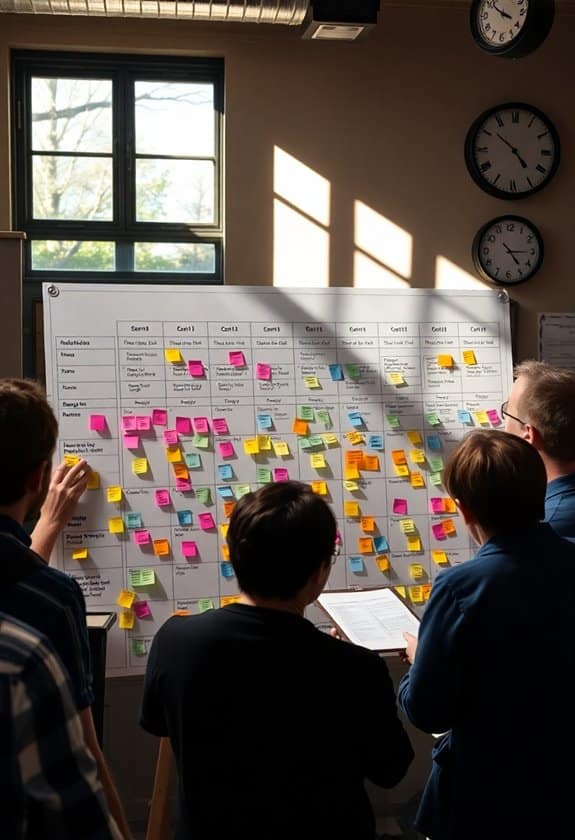
Whether you’re a seasoned filmmaker or just starting out, understanding the importance of scheduling is crucial for the success of your short film.
Imagine you’re on a film set—everyone’s ready, but there’s no clear plan. Chaos, right? A well-thought-out schedule keeps your crew safe and focused. It guarantees you have enough time to capture each scene without rushing.
I once misjudged a shoot, thinking we could wing it, and we ended up scrambling as the sunset! You’ve got to plan for unexpected hiccups, like weather changes or equipment issues.
A solid schedule reduces stress, making sure everyone knows what happens next. So, take a deep breath, grab a calendar, and start plotting your masterpiece. Your future self will thank you!
Setting Realistic Project Timelines

How do you guarantee your short film project stays on track? It starts with setting realistic timelines. You might feel the urge to rush, but remember, slow and steady wins the race.
Imagine you’re building a sandcastle; too fast, and it collapses. Break down your project into manageable chunks. Maybe filming takes three weeks, but editing could need another two.
Give each stage enough time, and add a safety buffer—life loves surprises! Once, I underestimated a scene’s complexity and ended up scrambling. Lesson learned!
Clear timelines help you avoid stress and ensure everyone’s on the same page. Communicate openly with your team, and don’t hesitate to adjust if needed. Being flexible keeps your project safe and sound.
Essential Pre-Production Planning

Pre-production planning is the backbone of any successful short film, setting the stage for everything that follows.
Imagine you’re starting a new adventure, where the organization keeps you safe and sound. To master this phase, focus on these key steps:
- Script Breakdown: Turn your script into a detailed plan, identifying locations, characters, and props. It’s like creating a treasure map that guides you safely.
- Budgeting: Allocate funds wisely. Picture budgeting as packing the right supplies for your journey, ensuring you’re prepared for any surprises.
- Securing Locations: Find and confirm locations early. Think of it as picking the safest campsites, ensuring everyone feels comfy and secure.
Additionally, consider investing in affordable filmmaking gear, which can help you stay within your budget while achieving high-quality results.
With thorough pre-production planning, you’ll create a strong foundation, making your filmmaking journey smoother and more enjoyable.
Building a Detailed Shooting Schedule
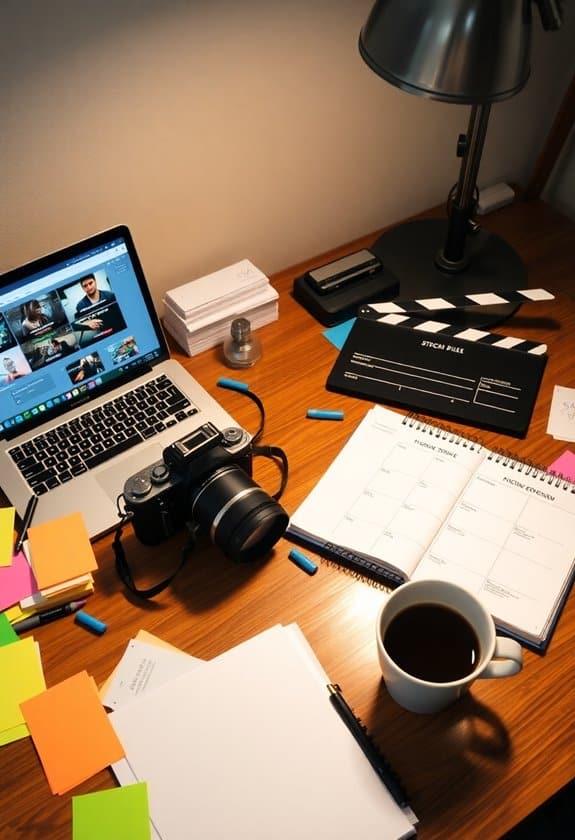
Creating a meticulous shooting schedule is the heartbeat of a well-organized film production. It’s like planning a road trip; you need to know when to take breaks and where to refuel.
To start, list all your scenes, considering the location, time of day, and each actor’s availability. Think of it as a giant puzzle where every piece needs to fit safely and snugly.
I’ve been there, juggling scenes like a circus performer, hoping everything would stay in the air. Remember to factor in extra time for unexpected delays—like when the lead actor gets stuck in traffic.
Safety first, so make sure everyone’s comfortable with the daily plan. With careful scheduling, you can keep the filmmaking journey smooth and hiccup-free!
Prioritizing Scenes for Efficiency

Efficiency is the name of the game when it comes to prioritizing scenes for your short film. You want to make sure every minute on set counts and trust me, that can be a challenge!
Start by grouping scenes that share locations or require the same props. This reduces setup time and keeps everyone safe from unnecessary chaos.
Here’s a simple approach:
- Location First: Shoot all scenes in one location before moving to the next. It minimizes travel, saving time and energy.
- Time of Day: Prioritize scenes based on natural light availability. Trust me, chasing sunlight isn’t fun!
- Complexity: Get the tough scenes done early when everyone’s fresh. It boosts morale and keeps everything running smoothly.
Managing Cast and Crew Availability
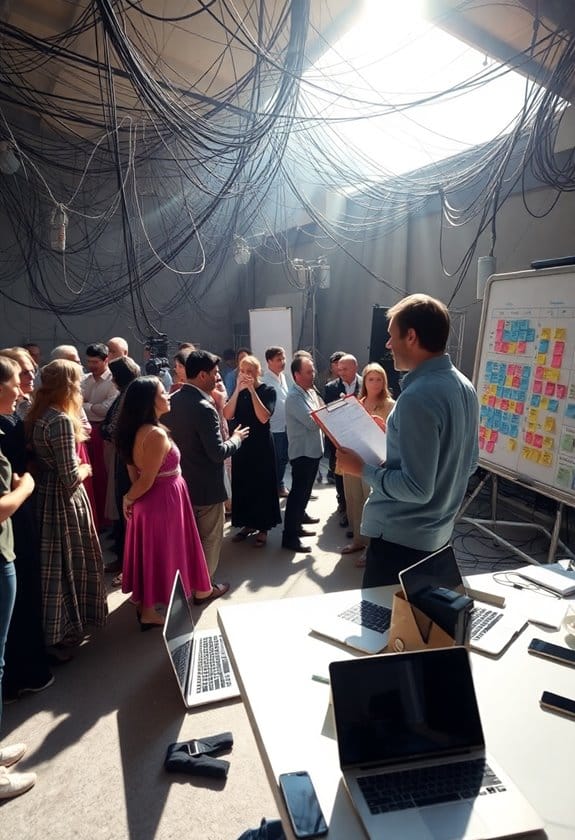
When it comes to managing cast and crew availability, timing is everything. You’ve got a great script, but coordinating everyone’s schedule can feel like solving a Rubik’s cube blindfolded.
First, gather everyone’s availability early on. It’s like organizing a big group chat but with fewer memes and more calendars. Make sure to account for everyone’s safety and comfort.
Keep communication open and honest—actors and crew appreciate knowing what to expect. Make a list of who’s needed wand hen, which helps avoid last-minute scrambles.
If someone’s unavailable, have a backup plan ready. Remember, flexibility is key. Filmmaking is a team effort, so think of it like a group project where everyone wants to get an A+.
You’ll master it with time!
Utilizing Scheduling Software

One essential tool in mastering the scheduling of short films is utilizing scheduling software. Imagine trying to juggle multiple tasks without it—chaos, right?
With scheduling software, you can feel safe knowing everything’s organized. Here’s how it helps:
- Centralized Information: Keep all your cast and crew details, shooting locations, and timeframes in one secure place. No need to worry about losing vital information.
- Automatic Updates: Any changes update across the board, ensuring everyone stays informed and stress-free. No more endless email chains or confusing messages.
- Conflict Detection: It quickly identifies scheduling conflicts, so you can address them before they become a problem, keeping your project on track.
Trust me, it’s a lifesaver when things get hectic!
Adapting to Unforeseen Changes
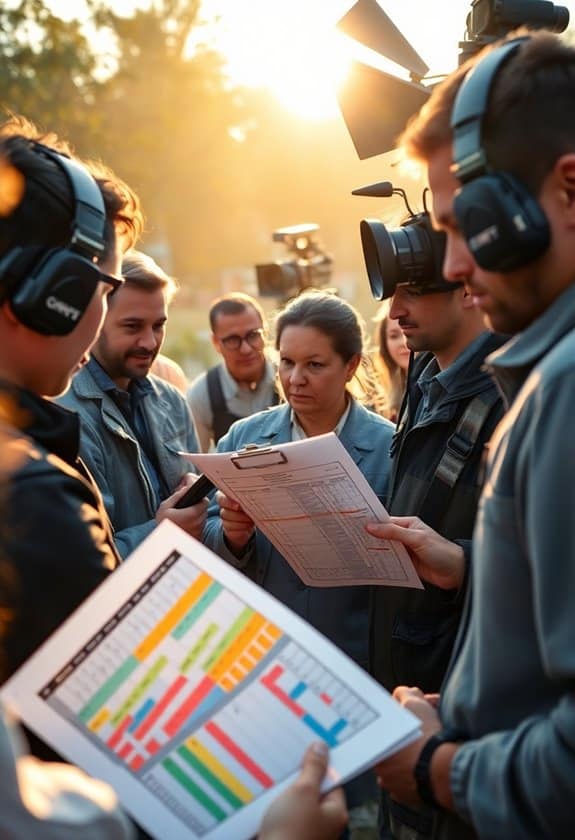
Unexpected challenges can easily disrupt your film’s schedule, but being adaptable is key to overcoming them.
Imagine you’re filming outside, and suddenly, rain clouds appear. Instead of panicking, consider this an opportunity. You could shoot an indoor scene or rework your script to embrace the weather. Flexibility guarantees your project stays on track.
Keep communication open with your team; everyone should know the plan B. I remember a time when a location fell through last minute. We used a nearby park instead, and it turned out better than expected!
Always have backup options. It’s like having an umbrella for those surprise storms. By staying calm and prepared, you’ll create a safe, positive environment, guaranteeing your film continues smoothly despite any hiccups. Additionally, having essential filmmaking equipment ready can help you adapt quickly to changing conditions on set.
Balancing Budget and Time

Budget-time management is essential when working on short films. You’re probably juggling a tight budget and limited time, which can feel like you’re walking a tightrope without a safety net.
But don’t worry, with careful planning, you’ll keep your film on track. Here are some tips to help balance your budget and time:
- Prioritize tasks: Determine what’s most important for your film, and focus your resources there. It’s like choosing the right toppings for a sundae—pick what matters most.
- Create a detailed schedule: Break down each day, including buffer times for unexpected delays. Trust me, they happen!
- Use affordable resources: Explore cost-effective equipment rentals or local talent. It’s amazing what you can achieve without breaking the bank. Additionally, consider investing in a tripod for stability, as having the right gear for filmmakers can significantly enhance your production quality.
Staying organized guarantees a smoother process and keeps everyone safe.
Post-Production Time Management
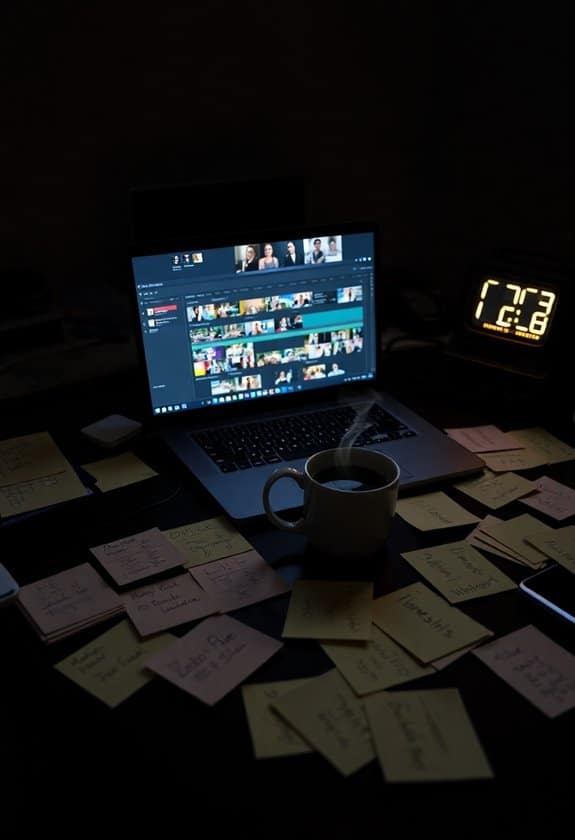
As you wrap up the whirlwind of shooting, it’s time to shift focus to post-production time management—a phase that demands just as much precision and care.
You’re probably excited to see your film come together but remember, editing, sound design, and color grading require a plan. Create a timeline, setting realistic deadlines for each task, so you won’t feel rushed.
I once underestimated editing time and found myself scrambling at the last minute—talk about a nail-biter! It’s essential to leave room for unexpected hiccups.
Keep communication open with your team, ensuring everyone knows their roles and deadlines. This way, you’ll maintain a safe environment where creativity thrives and stress stays at bay.
Your film deserves this thoughtful attention!
Frequently Asked Questions
How Can I Handle Last-Minute Changes to the Shooting Schedule Effectively?
When life throws you a curveball, don’t panic about last-minute schedule changes.
First, guarantee everyone’s in the loop; clear communication keeps chaos at bay.
Keep a backup plan handy, like rearranging scenes that don’t need specific lighting or location.
It’s a bit like juggling, but with practice, you’ll get the hang of it.
Trust your instincts and stay flexible.
What Strategies Help in Maintaining Crew Motivation During Tight Schedules?
Keeping your crew motivated during those tight schedules can feel like juggling flaming torches, but it’s totally doable!
Start by ensuring everyone feels heard and valued, like sharing your own experiences of overcoming challenges. Little things, like bringing surprise snacks or cracking a light joke, can do wonders.
Remind them of the bigger picture and the passion driving the project. Celebrate small victories, keeping spirits high and teamwork strong.
How Do I Coordinate Location Availability With the Shooting Schedule?
Coordinating location availability with your shooting schedule can be tricky, but you’ve got this!
First, make a list of your required locations, then contact each one to check their availability. It’s like setting up playdates for your scenes!
Once you’ve got the dates, match them with your script needs. Flexibility is key here; sometimes you’ve got to shuffle scenes around.
Keep communication open with location managers, and always have a backup plan—just in case!
Are There Any Tips for Managing Equipment Rentals Within a Strict Timeline?
Imagine you’re juggling flaming torches, but they’re actually cameras and lights. Managing equipment rentals within a tight timeline feels like that.
You should call rental places early; they’re like superheroes with gear. Always have a backup plan because sometimes equipment gets lost in transit, like socks in a dryer.
Keep a checklist to track everything. Remember, it’s okay to ask for help; even the best filmmakers need a safety net.
How Can I Minimize Downtime Between Scenes on Set?
To minimize downtime between scenes, always plan ahead, like a mini director with a superpower!
You can prep everything beforehand: organize costumes, props, and scripts, and make sure everyone knows their roles.
Think of it like a school play but with fewer cardboard trees.
Keep communication open—walkie-talkies can be your best friends here.




